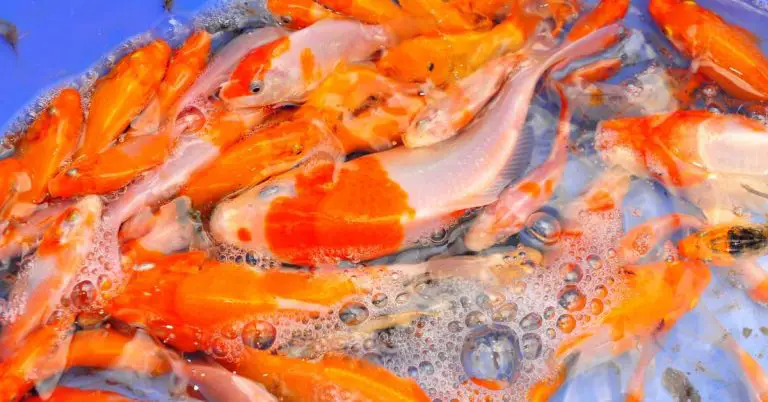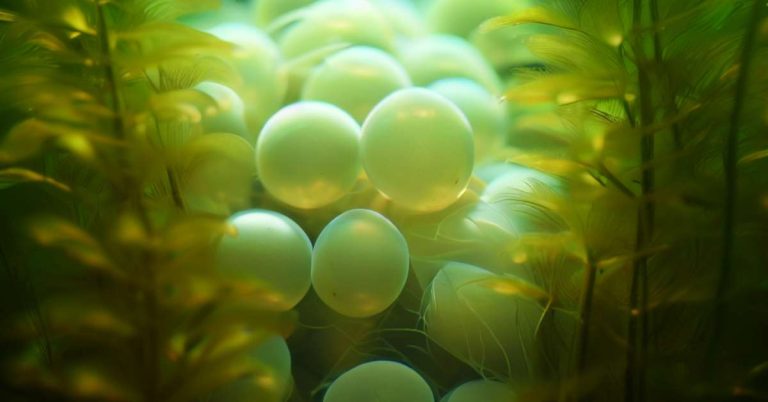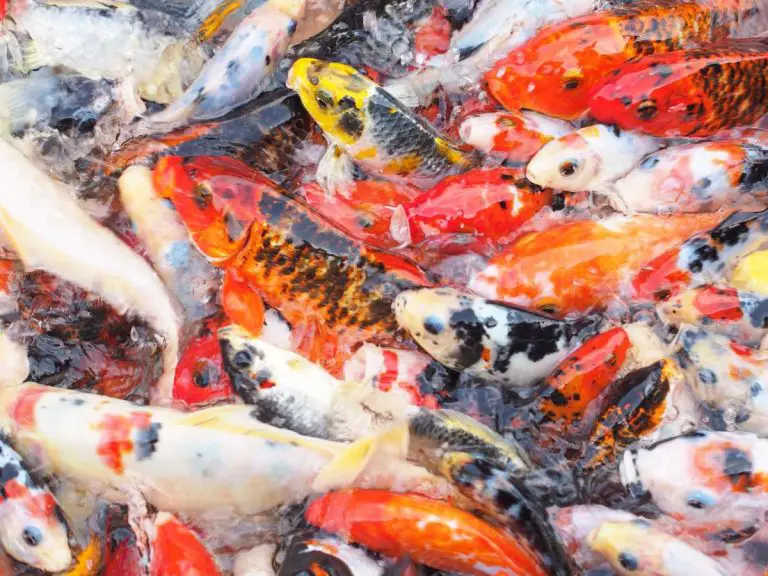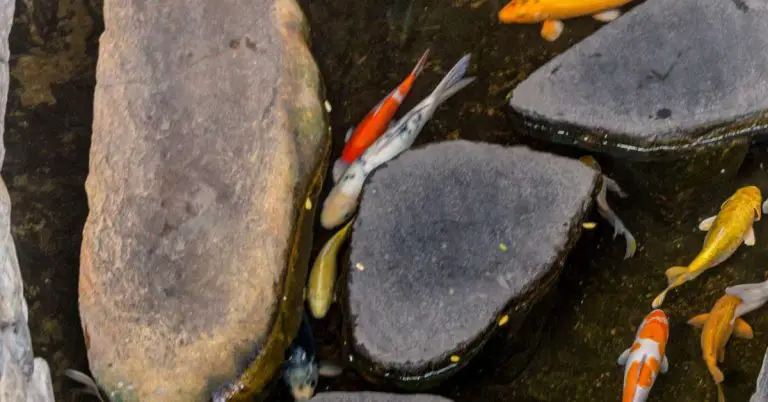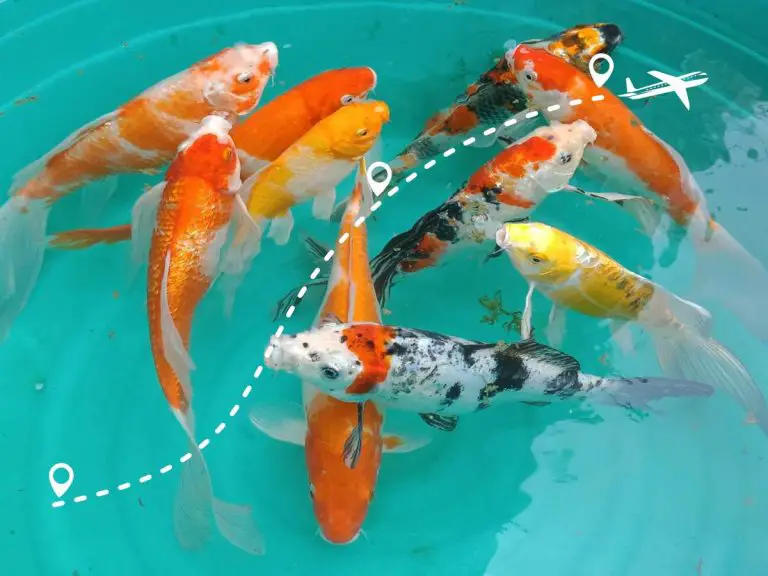Koi Varieties: Complete List of All The Different Types of Koi – Plus How To Choose Them!
Koi fish come in a wide range of varieties with distinct characteristics, colors, patterns, and sizes. Whether you’re a pond owner or a fish enthusiast, learning about the different koi fish breeds can be both educational and fascinating.
Understanding the various koi fish breeds is instrumental in appreciating their diverse beauty and selecting the right koi variety for your pond. Each breed has its own set of characteristics and unique appeal. By exploring the world of koi fish breeds, you’ll gain insight into the different traits that make these aquatic creatures so captivating.
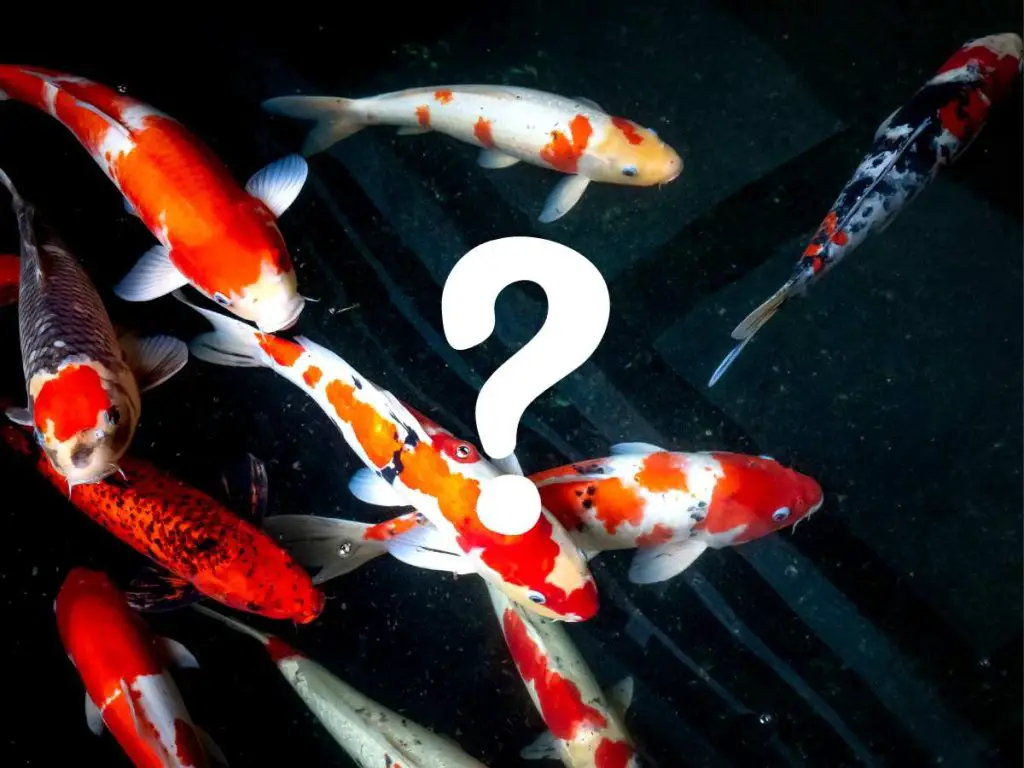
Here’s what you need to know.
How many types of koi are there?
First things first – how many types of koi are there? Well, it depends on who you ask, and how you’re counting!
So let’s make sure we’re on the same page when it comes to identifying koi. There are hundreds of variations of koi, and so there’s also lots of ways to goup them, too. Many of these categories are based on color patterns.
But first, let’s explore some broad categories that are based on specific characteristics, rather than color or pattern.
For example, here are three popular types of koi:
- Doitsu Koi: The term “Doitsu” refers to koi that have either no scales or a limited number of large, mirror-like scales along the dorsal and lateral lines. The Doitsu trait can be found in many koi varieties. For example, you can have a Doitsu Kohaku (a Kohaku pattern koi without the regular scaling). The Doitsu trait originated from crossbreeding with German carp, which is why they are sometimes referred to as “German carp” or “German scale.”
- Kin Gin Rin Koi: The term “Kin Gin Rin” refers to koi with shiny, reflective scales. “Kin” means gold, and “Gin” means silver, while “Rin” refers to the scales. So, Kin Gin Rin koi have scales that sparkle in gold or silver. Like Doitsu, the Kin Gin Rin trait can be found in various koi varieties. For instance, a Kohaku with these shiny scales would be called a Kin Gin Rin Kohaku.
- Butterfly Koi: Recognizable by their long, flowing fins that resemble butterfly wings, Butterfly koi are a hybrid variety, blending traditional koi with long-finned carp, resulting in a graceful and elegant appearance.
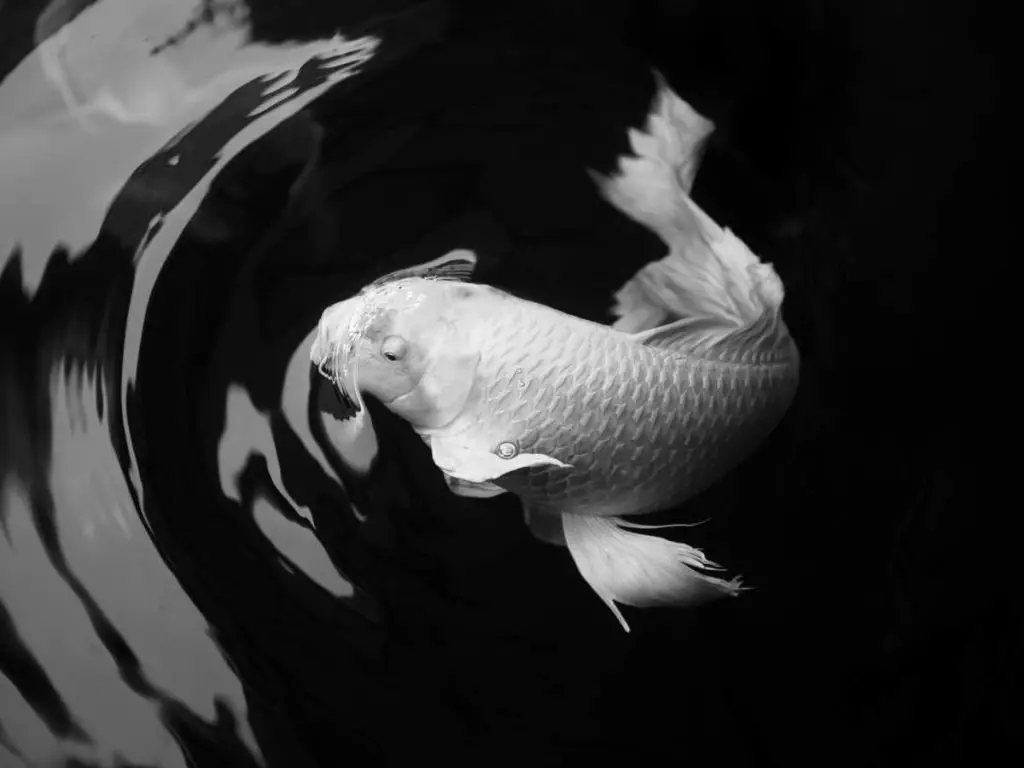
As we’ll explore further below, koi are most often grouped according to their color and markings. But there are even more broad categories we can use to understand koi:
Scale Types:
- Doitsu: As mentioned earlier, these are koi with either no scales or a limited number of large, mirror-like scales.
- Fully Scaled: The typical koi with regular, full coverage of scales.
- Leather Carp: These are koi that are completely devoid of scales.
Body Shape:
- Traditional: The typical body shape of koi.
- Chagoi: Often larger and more robust than other koi, Chagoi are known for their friendly nature and can be various colors, but they have a distinct body shape.
Unique Features:
- Tancho: Koi with a single red spot on the head. This trait can be seen in various varieties like Tancho Kohaku, Tancho Sanke, etc.
- Goshiki: Translates to “five colors.” While often considered a color pattern, the interplay of colors in Goshiki is so unique that it can be considered a characteristic-based category.
Texture and Depth of Color:
- Matsuba: Koi with a pinecone pattern, where each scale has a center of a different color, giving a reticulated appearance.
And to make matters even more complicated, there are many distinct, broad groups of koi, sometimes referred to as ‘koi breeds.’ While all koi are the same species (Cyprinus carpio), people have been breeding them since the 4th century (one of my favorite koi facts!). So for hundreds of years, people have been selecting koi to have certain desired qualities – leading to some significant differences between certain breeds.
And finally, within each breed there’s a seemingly limitless amount of variations, often based on coloring (it’s kind of like how you can have a hamburger, and a hamburger with cheese, and a hamburger with cheese and tomato, and so on).
Again, there are hundreds of variations of koi. To help you wade through them, I’ve compiled them into what are broadly recognized as the 13 major breeds of koi. And within each breed, I’ve highlighted the most common/popular examples of them. Find it next!
Koi Varieties and Names
In the following list, numbers refer to overarching groups of koi (aka koi breeds), while the bullets below each number refer to variations within that group.
1. Gosanke (The “Big Three” Koi Varieties)
Gosanke represents the three most popular and prestigious koi varieties. They are often the centerpiece of koi shows and competitions.
- Kohaku: A classic variety, the Kohaku boasts a pristine white body contrasted by vibrant red patterns. The balance and placement of these red patterns are crucial to its value.
- Sanke (Taisho Sanshoku): The Sanke combines the beauty of the Kohaku with additional black patterns. These black markings, combined with the white body and red patterns, create a harmonious tri-color design.
- Showa (Showa Sanshoku): The Showa is characterized by its dominant black body, adorned with red and white patterns. Unlike the Sanke, the black of the Showa is more prominent, often forming the base color.
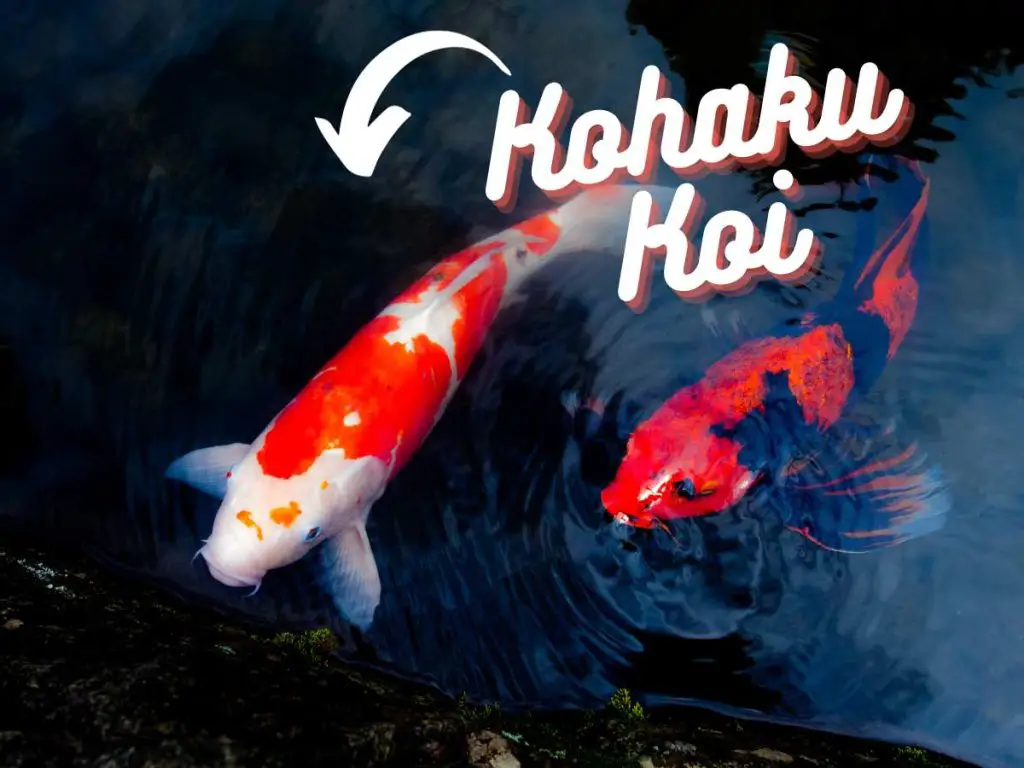
2. Bekko
Bekko koi are recognized for their solid-colored bodies with contrasting black patterns. The name “Bekko” translates to “tortoiseshell” in Japanese.
- Shiro Bekko: This variety features a clean white body as its canvas, upon which black patterns elegantly sprawl.
- Aka Bekko: A striking red body serves as the backdrop for the Aka Bekko’s black patterns.
- Ki Bekko: The Ki Bekko showcases a sunny yellow body, contrasted by its signature black markings.
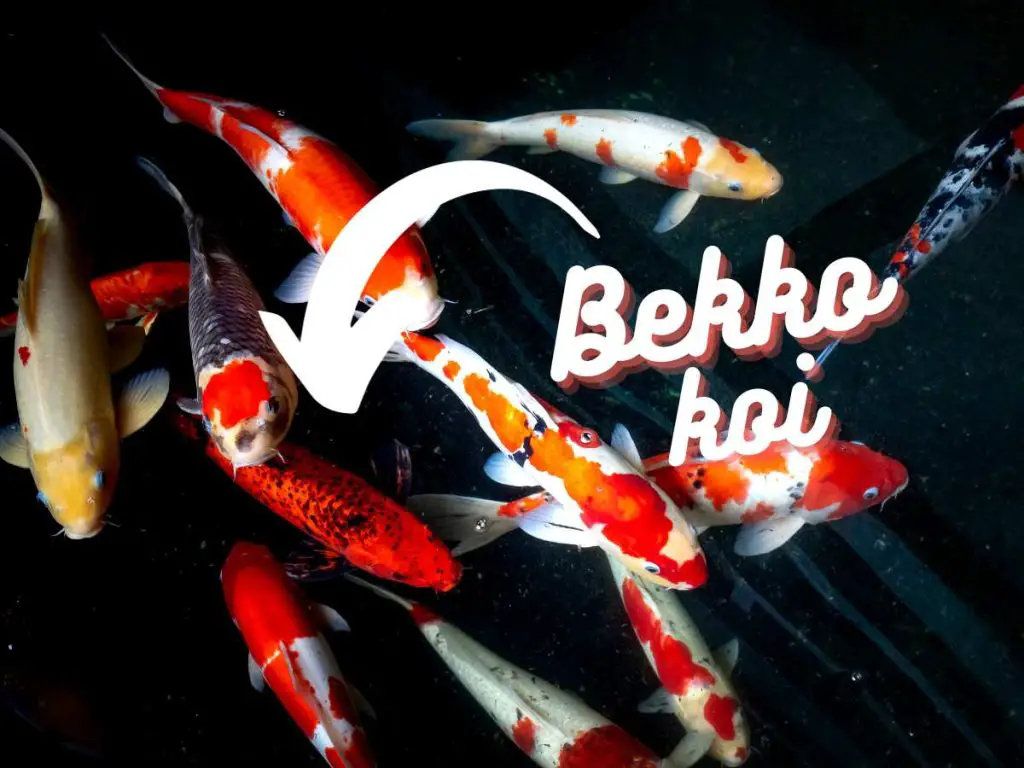
3. Utsurimono
Derived from the word “Utsuri,” meaning “to reflect,” the Utsurimono koi are known for their two-tone color patterns.
- Shiro Utsuri: A captivating interplay of black and white, the Shiro Utsuri features a white body with bold black patterns.
- Hi Utsuri: This variety combines a deep red body with contrasting black patterns, creating a fiery appearance.
- Ki Utsuri: The Ki Utsuri presents a yellow body, offset by its dramatic black patterns.
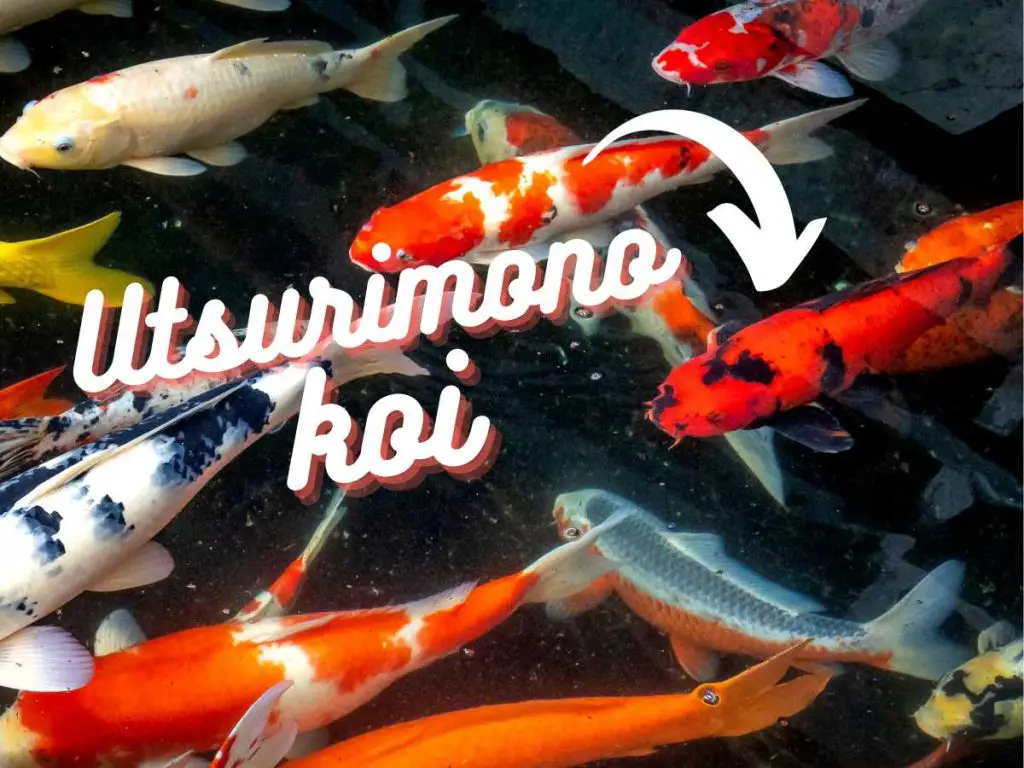
4. Asagi & Shusui
Both Asagi and Shusui are known for their blue scales, but they differ in scale patterns and distribution.
- Asagi: The Asagi is characterized by its light blue scales on the upper body, with a complementing red or orange hue on its lower body and fins.
- Shusui: Essentially the scaleless version of the Asagi, the Shusui displays a similar color distribution but with a more streamlined appearance due to its Doitsu lineage.

5. Goromo & Goshiki
Koromo means “robed” and Goshiki translates to “five colors.” Both varieties are celebrated for their intricate patterns and vibrant hues.
- Ai Goromo: The Ai Goromo is reminiscent of the Kohaku but is distinguished by its blue-edged scales that overlay the red patterns.
- Sumi Goromo: Similar to the Ai Goromo, the Sumi Goromo features black-edged scales over its red patterns.
- Budo Goromo: A beautiful variation of the Goromo, the Budo Goromo has patterns that resemble grape clusters. It has a white base with deep blue or purple reticulated patterns over red patches, giving it the appearance of grape bunches.
- Goshiki: A visual feast, the Goshiki boasts a white body adorned with a blend of red, black, blue, and dark blue patterns.
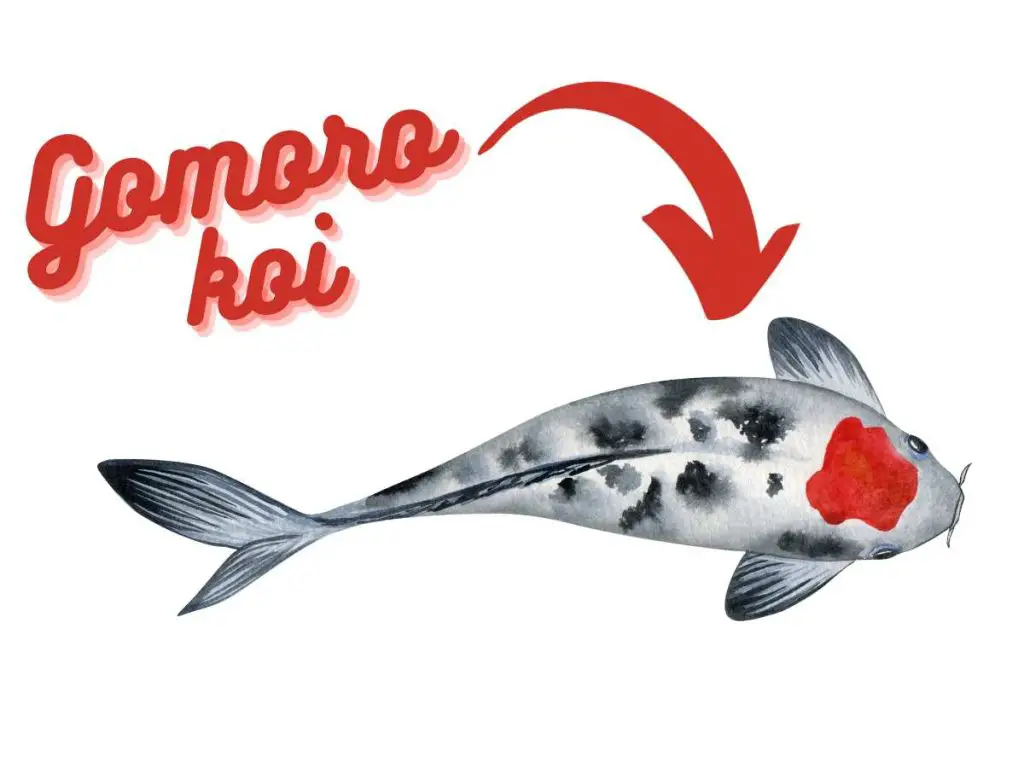
6. Hikarimuji
The term “Hikarimuji” refers to koi with a single, solid metallic color. These koi have a radiant sheen that makes them stand out.
- Platinum Ogon (Purachina): A shimmering metallic silver koi, the Platinum Ogon is like a living jewel in the water.
- Yamabuki Ogon: This variety glows with a solid, metallic gold hue, reminiscent of a golden nugget.
7. Hikariutsuri
Hikariutsuri koi are a blend of the Utsurimono patterns with a metallic sheen, giving them a unique sparkle.
- Kin Showa: A Showa with an added twist, the Kin Showa gleams with a metallic sheen, enhancing its tri-color patterns.
- Gin Shiro Utsuri: This variety takes the Shiro Utsuri’s black and white patterns and adds a touch of metallic gloss.
8. Hikarimoyo
Hikarimoyo koi are characterized by their metallic sheen and multi-colored patterns.
- Yamato Nishiki: Essentially a metallic Sanke, the Yamato Nishiki sparkles with its tri-color design.
- Kujaku: The Kujaku is a radiant white, metallic koi, known for its reticulated net-like patterns combined with red or orange patterns.
- Hariwake: A dazzling metallic koi, the Hariwake features orange or yellow patterns set against a luminous white background.
- Matsuba: The Matsuba koi are known for their solid color base with a pinecone pattern on their back. This pinecone pattern is created by a reticulated net-like pattern in the scales. Depending on the base color, they can be classified further, such as “Akamatsuba” for red and “Kinmatsuba” for gold.
9. Tancho
Tancho koi are revered for their simplicity. They are characterized by a solid body color with a single red spot on the head, resembling the Japanese flag.
- Tancho Kohaku: A pure white body with a singular red spot on its head defines the Tancho Kohaku.
- Tancho Sanke: Building on the Tancho Kohaku, the Tancho Sanke adds subtle black patterns to the mix.
- Tancho Showa: The Tancho Showa stands out with its black body, white patterns, and the signature red spot on the head.
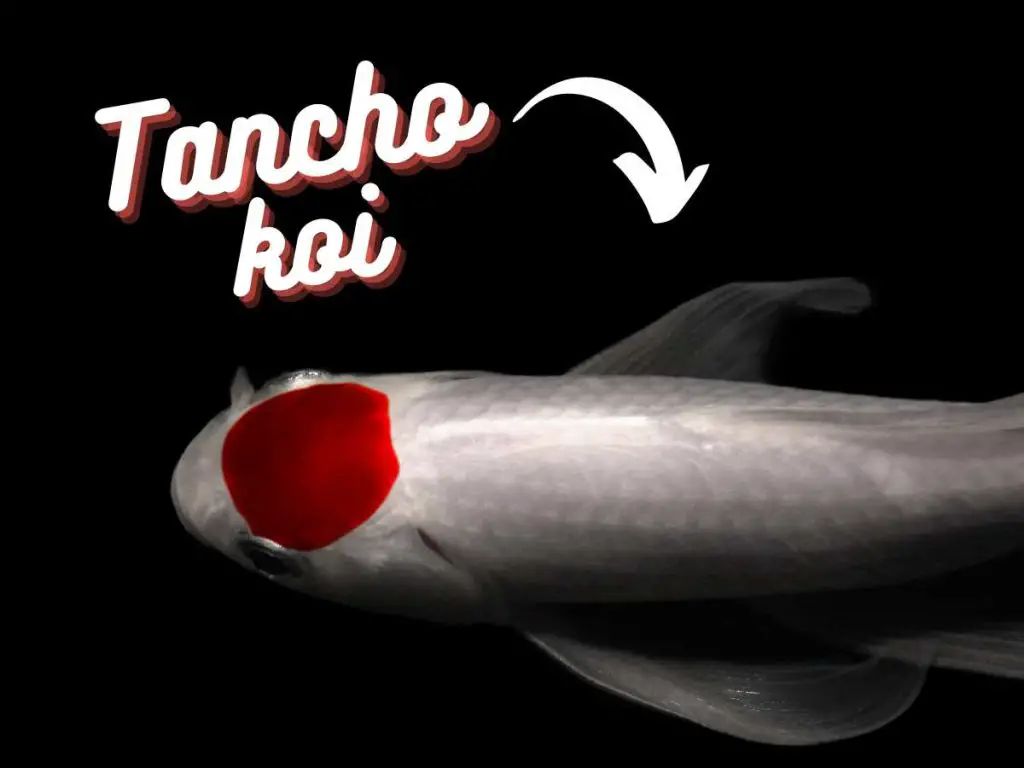
10. Doitsu (Scaleless or Partially Scaled Varieties)
Originating from German carp, Doitsu koi have either no scales or a line of large scales running along their lateral and dorsal lines. This gives them a distinct and smooth appearance.
- Doitsu Varieties: Since term “Doitsu” simply refers to the lack or low amount of scales, it can be applied to many koi varieties. Here are some examples:
- Doitsu Sanke: A Sanke koi (white body with red and black patterns) that is scaleless or has a limited number of scales.
- Doitsu Showa: A Showa koi (black body with red and white patterns) with the Doitsu scale pattern.
- Doitsu Ochiba Shigure: A combination of the Ochiba Shigure variety (blue-gray with brown patterns) and the Doitsu scale pattern.
- Doitsu Hariwake: A Hariwake koi (metallic koi with orange or yellow patterns against a white background) with the Doitsu scale pattern.
- Doitsu Kujaku: A Kujaku koi (white, metallic koi with reticulated net-like patterns and red/orange patterns) in the Doitsu form.
- … and many more. Almost any koi variety can have a Doitsu version, which means that variety exhibits the scaleless or partially scaled characteristic of Doitsu koi.
- Beni Kumonryu: A striking and dynamic Doitsu koi that features swirling patterns of red and white on a jet-black background. The patterns can change over time, adding to its mystique.
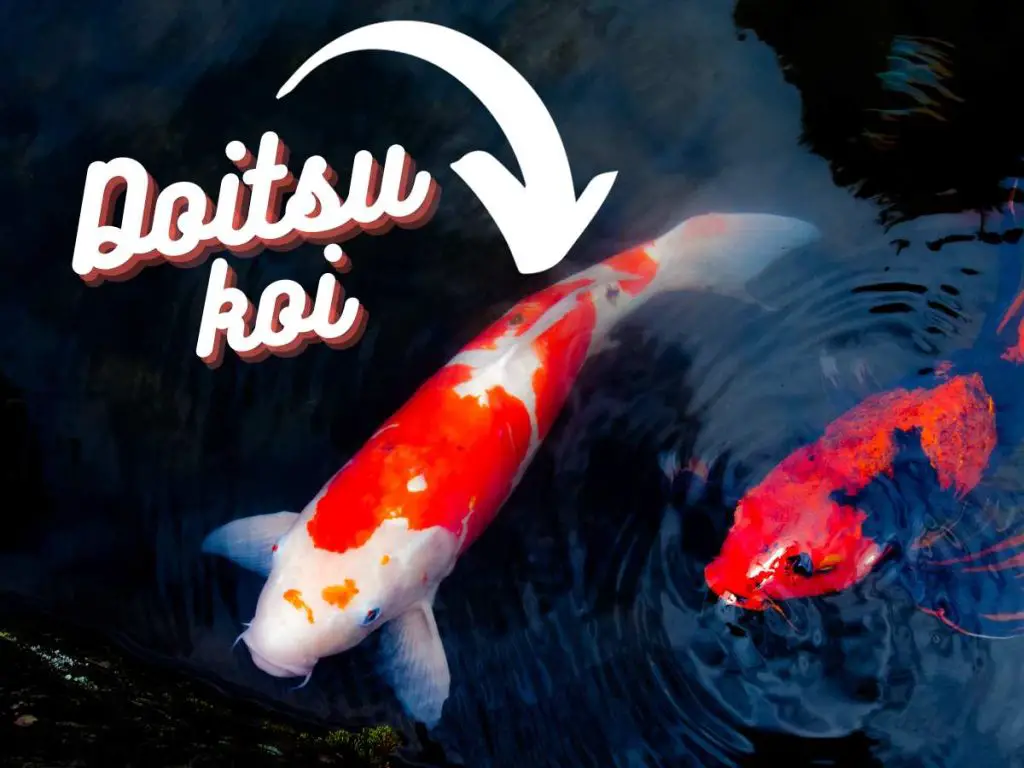
11. Kin Gin Rin (Sparkling Scaled Varieties)
The term “Kin Gin Rin” is derived from Japanese words where “Kin” means gold, “Gin” means silver, and “Rin” refers to scales. Thus, “Kin Gin Rin” translates to “gold and silver scales.” These koi are known for their unique, sparkling scales that shimmer and reflect light, giving them a radiant appearance. The glittering effect is due to a genetic mutation that causes the scales to have a reflective quality. This trait can be found in various koi varieties, leading to multiple Kin Gin Rin types. Here are some examples:
- Kin Gin Rin Varieties: Similiar as with Doitsu, ‘Kin Gin Rin’ refers to the reflective quality of scales only. Whether it’s a Kin Gin Rin Kohaku or Sanke, these koi shimmer with their reflective scales, adding an extra layer of beauty to their patterns. This trait can therefore be found in various koi varieties, leading to multiple Kin Gin Rin types. Here are some examples:
- Kin Gin Rin Kohaku: A Kohaku koi (white body with red patterns) that has the distinctive sparkling scales.
- Kin Gin Rin Sanke: A Sanke koi (white body with red and black patterns) with the shimmering Kin Gin Rin scales.
- Kin Gin Rin Showa: A Showa koi (black body with red and white patterns) that exhibits the radiant Kin Gin Rin scale trait.
- Kin Gin Rin Asagi: An Asagi koi (light blue scales on the top and red on the bottom) with the characteristic sparkling scales.
- Kin Gin Rin Ochiba Shigure: An Ochiba Shigure koi (blue-gray with brown patterns) with the Kin Gin Rin trait.
- Kin Gin Rin Chagoi: A Chagoi koi (olive green) that shimmers with the Kin Gin Rin scales.
- Kin Gin Rin Tancho: A Tancho koi (white body with a single red spot on the head) that has the sparkling Kin Gin Rin scales.
- … and many more. The Kin Gin Rin trait can be combined with almost any koi variety, leading to a wide range of shimmering, radiant koi.
12. Kawarimono (Miscellaneous Varieties)
Kawarimono is a catch-all category for koi that don’t fit into the standard classifications. They come in a wide range of colors and patterns.
- Chagoi: Known for its friendly nature, the Chagoi has an olive green hue that blends seamlessly with pond environments.
- Soragoi: The Soragoi exudes a calming presence with its gray or blue hue, often likened to the color of the sky.
- Ochiba Shigure: Its name translates to “leaves on water,” and the Ochiba Shigure captures this essence with its blue-gray body interspersed with brown patterns.
- Kigoi: A vibrant and lively koi, the Kigoi stands out with its bright yellow coloration.
- Midorigoi: True to its name, which means “green,” the Midorigoi has a unique green hue.
- Kikusui: A Doitsu version of the Hariwake, the Kikusui shines with its scaleless white body and orange or yellow patterns.
13. Hikarizoyo
Hikarizoyo koi are a subset of the Hikarimono group, known for their metallic sheen combined with two or more colors.
- Ghost Koi: A hybrid variety, the Ghost Koi is a blend of wild carp and Ogon koi. It stands out with its metallic sheen, adorned with ghostly patterns that give it its name.
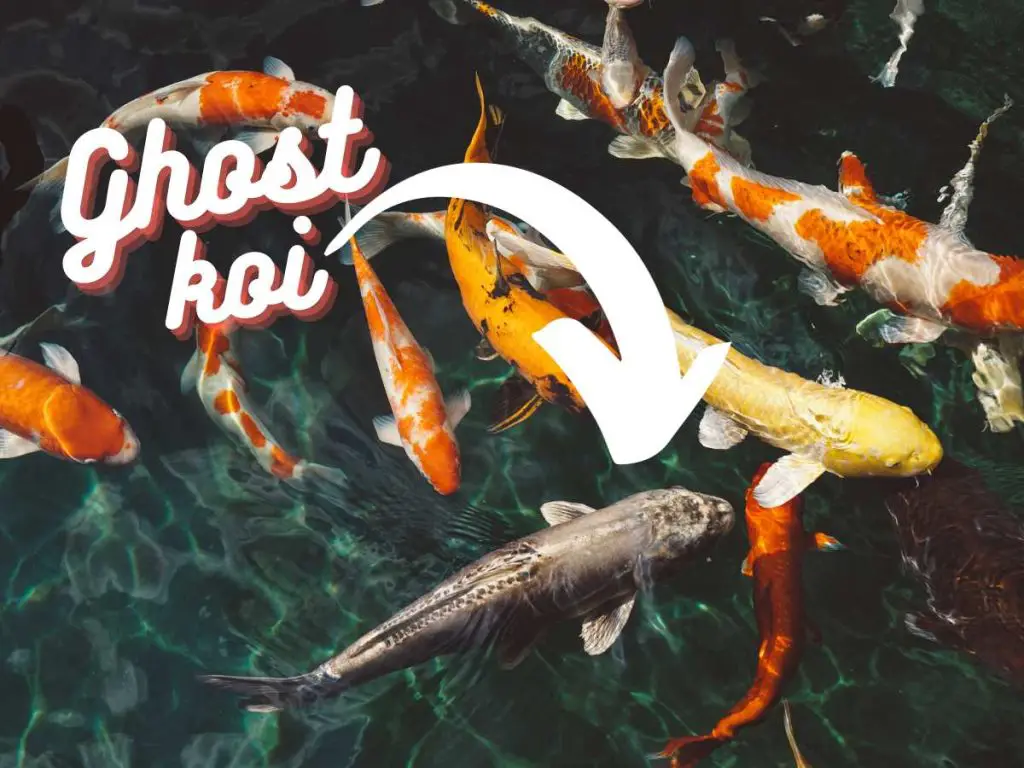
14. Hirenaga or Longfin Koi
Longfin koi, also known as “Hirenaga” or “Butterfly Koi,” are characterized by their elongated and flowing fins, which give them a graceful and ethereal appearance. They are a result of crossbreeding traditional koi with Asian carp. Here are some popular varieties of longfin koi:
- Longfin Kohaku: This variety has a white body with red patterns, similar to the traditional Kohaku but with elongated fins.
- Longfin Sanke (Longfin Taisho Sanshoku): White-bodied koi with red and black patterns, enhanced by the flowing fins.
- Longfin Showa (Longfin Showa Sanshoku): Black-bodied koi with red and white patterns, again characterized by the long fins.
- Longfin Utsuri: These can come in various combinations like Shiro Utsuri (white body with black patterns), Hi Utsuri (red body with black patterns), and Ki Utsuri (yellow body with black patterns), all having the signature long fins.
- Longfin Ogon: Metallic koi that can be in various colors like gold (Yamabuki Ogon) or silver (Platinum Ogon), with the defining long fins.
- Longfin Chagoi: The friendly and often large olive green koi, now with flowing fins.
- Longfin Asagi: Light blue scales on the top and red on the bottom, with the characteristic long fins.
- Longfin Shusui: The Doitsu (scaleless) version of Asagi, but with long fins.
- Longfin Bekko: Whether it’s Shiro Bekko, Aka Bekko, or Ki Bekko, the longfin version has the same color patterns but with elongated fins.
- Longfin Koromo & Goshiki: These varieties, known for their intricate patterns, look even more elegant with the long fins.
- Longfin Tancho: Whether it’s Tancho Kohaku, Tancho Sanke, or Tancho Showa, the long fins add an extra layer of beauty to the single red spot on the head.
- Longfin Matsuba: With their pinecone pattern and solid color base, the long fins make them even more striking.
These are just a few examples. Essentially, many of the traditional koi varieties can have a longfin version. The elongated fins add a unique beauty and grace to each variety.
Remember, the world of koi breeding is vast, and new varieties or sub-varieties can emerge as breeders experiment with different combinations. The ones listed above are some of the more recognized and established varieties today. Who knows what tomorrow will bring!
Koi Varieties Chart
| Group | Variety | Description |
|---|---|---|
| Gosanke (The “Big Three”) | Kohaku | White body with vibrant red patterns. |
| Sanke (Taisho Sanshoku) | White body with red and additional black patterns. | |
| Showa (Showa Sanshoku) | Dominant black body with red and white patterns. | |
| Bekko | Shiro Bekko | White body with black patterns. |
| Aka Bekko | Red body with black patterns. | |
| Ki Bekko | Yellow body with black patterns. | |
| Utsurimono | Shiro Utsuri | White body with black patterns. |
| Hi Utsuri | Red body with black patterns. | |
| Ki Utsuri | Yellow body with black patterns. | |
| Asagi & Shusui | Asagi | Light blue scales on top, red or orange on the bottom. |
| Shusui | Scaleless version of Asagi. | |
| Goromo & Goshiki | Ai Goromo | Kohaku with blue-edged scales over red patterns. |
| Sumi Goromo | Kohaku with black-edged scales over red patterns. | |
| Budo Goromo | White base with blue or purple reticulated patterns over red. | |
| Goshiki | White body with blend of red, black, blue, and dark blue patterns. | |
| Hikarimuji | Platinum Ogon (Purachina) | Metallic silver koi. |
| Yamabuki Ogon | Metallic gold koi. | |
| Hikariutsuri | Kin Showa | Metallic Showa. |
| Gin Shiro Utsuri | Metallic Shiro Utsuri. | |
| Hikarimoyo | Yamato Nishiki | Metallic Sanke. |
| Kujaku | Metallic white koi with net-like patterns and red/orange patterns. | |
| Hariwake | Metallic koi with orange/yellow patterns on a white background. | |
| Matsuba | Solid color with pinecone pattern on back. | |
| Tancho | Tancho Kohaku | White body with single red spot on head. |
| Tancho Sanke | White body with red spot and black patterns. | |
| Tancho Showa | Black body with red spot and white patterns. | |
| Doitsu | Doitsu Varieties | Scaleless or partially scaled versions of various koi types. |
| Kin Gin Rin | Kin Gin Rin Varieties | Varieties with reflective, shimmering scales. |
| Kawarimono | Chagoi | Friendly olive green koi. |
| Soragoi | Calming gray or blue koi. | |
| Ochiba Shigure | Blue-gray body with brown patterns. | |
| Kigoi | Vibrant yellow koi. | |
| Midorigoi | Unique green koi. | |
| Kikusui | Scaleless Hariwake. | |
| Hikarizoyo | Ghost Koi | Hybrid with metallic sheen and ghostly patterns. |
| Hirenaga or Longfin Koi | Longfin Varieties | Traditional koi varieties with elongated fins. |
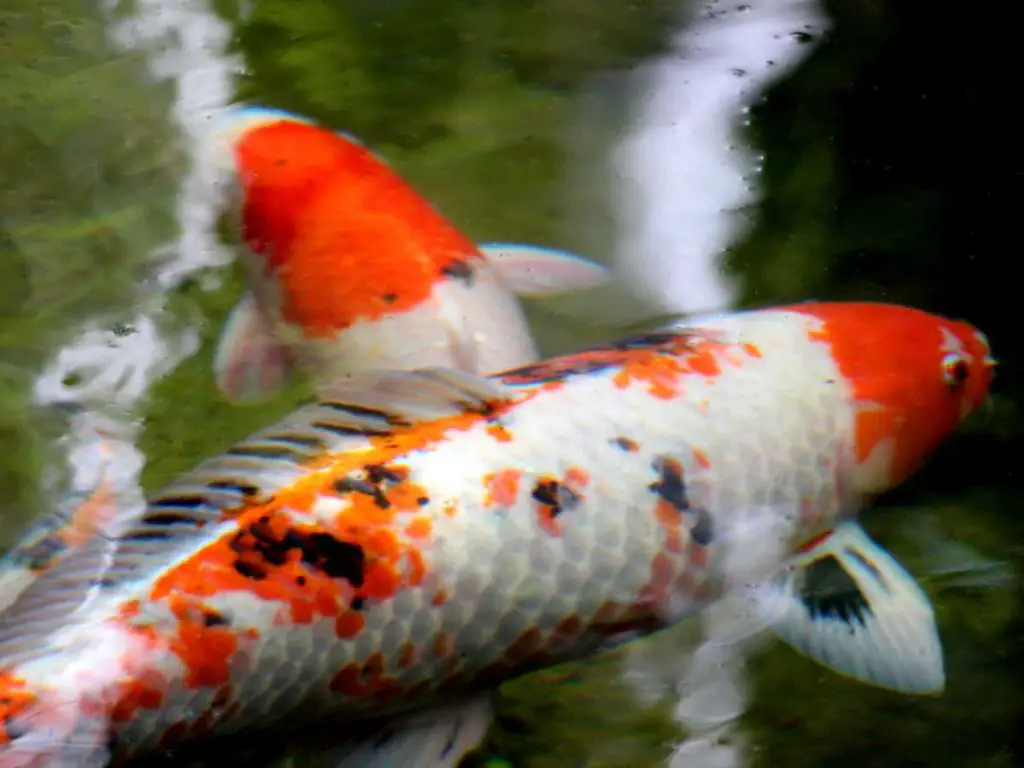
Koi Fish Colors and Patterns: Popular color variations in koi fish
Koi fish are known for their stunning colors and unique patterns, which add a touch of beauty to any pond or garden. Let’s explore some of the popular color variations you can find in these mesmerizing creatures.
Red (Hi): This vibrant color symbolizes energy, power, and prosperity. Red koi fish, also known as Hi, can range from a deep crimson hue to a more muted shade of orange. Their eye-catching color instantly grabs your attention and adds a fiery touch to your pond.
White (Shiro): The color white, or Shiro, represents purity, simplicity, and elegance. White koi fish have a timeless beauty that can complement any pond or garden theme. From pure snow-white to creamy off-white shades, these koi fish exude tranquility and grace.
Black (Sumi): Black koi, or Sumi, radiate power and strength. These majestic creatures display bold black markings against a contrasting background, which can range from vibrant red to elegant white. The allure of black koi fish lies in their dramatic and mysterious appearance.
Yellow (Ki): Yellow koi, known as Ki in Japanese, are a symbol of wealth and prosperity. Their golden hues can range from pale, almost pastel yellow to a deep, rich gold. These koi bring a sense of warmth and sunshine to any pond, reflecting their radiant color in the water and shining brightly on sunny days.
Blue (Ai): Blue koi, referred to as Ai, are less common than some other colors but are highly prized for their unique and serene appearance. They can range from deep indigo to lighter shades of blue. The color blue in koi often symbolizes peace, tranquility, and calmness, making them a favorite for those seeking a peaceful ambiance in their water gardens.
Orange (Orenji): Orange koi, known as Orenji, are vibrant and energetic, often resembling the color of a setting sun. They can range from a bright tangerine to a more muted rust hue. Their lively coloration brings a sense of joy and enthusiasm to any pond setting.
Choosing the Right Koi Variety: Factors To Consider
When it comes to choosing the right koi variety, there are a few key factors that you should consider. These factors will help you narrow down your options and select the perfect koi fish for your pond or garden.
1. Pond or garden size: The size of your pond or garden will play a significant role in determining the ideal koi variety for you. Some varieties, such as the Kohaku, require more space to swim around and showcase their vibrant colors. On the other hand, smaller varieties like the Bekko can thrive in smaller ponds.
2. Temperature and climate: Different koi varieties have varying temperature and climate preferences. It’s crucial to choose a variety that can withstand the climate conditions in your region. For example, if you live in an area with colder winters, you might want to consider hardier varieties like the Asagi, which can handle lower temperatures.
3. Price & Availability: It’s never been easier to get heatlhy, high-quality koi fish, thanks to the proliferation of reputable online koi breeders and sellers. That said, koi have sold for upwards of $1 million, and of course depending on where you live, you have may issues importing koi.
When sourcing quality koi within your budget, it’s essential to research and identify reputable breeders or dealers who have positive reviews and a history of providing healthy fish. Additionally, attending koi shows or joining koi enthusiast groups can offer insights and recommendations on obtaining top-quality koi at various price points.
4. Personal preferences: Ultimately, your personal preferences should guide your choice of koi variety. Do you prefer bold, vibrant colors or more subtle patterns? Take some time to explore different varieties and see which ones resonate with you the most. After all, the beauty of keeping koi fish is that you get to enjoy them and connect with them on a personal level.
By considering these factors, you can ensure that you make an informed decision when choosing a koi variety. Remember, each variety has its own unique charm and characteristics, so take the time to do your research and find the perfect koi fish that suits your needs and preferences.
Koi Fish Sizes and Growth Rates
Thinking about biting the bullett and investing in some koi for your backyard pond? Here’s what you can expect.
Koi fish (even the rarest koi fish!) go through three distinct growth phases, each with its own characteristics and considerations.
1. Tosai (juvenile): During the tosai phase, koi fish are still in the early stages of development. They are typically around 4 to 6 inches long and have vibrant colors. Tosai koi are highly vulnerable and require extra care and attention.
2. Nisai (yearling): As koi fish enter the nisai phase, they are approximately 1 to 2 years old and have grown to around 8 to 12 inches in size. This is an exciting phase as their patterns and colors start to develop further, making them even more mesmerizing to watch.
3. Sansai (three-year-old): Once koi fish reach the sansai phase, they have reached adulthood. They are now about 18 to 24 inches long, and their colors and patterns have fully matured. Sansai koi fish are considered to be at their prime and are a sight to behold.
Now that we’ve covered the growth phases, let’s explore how you’ll actually care for your koi varieties.
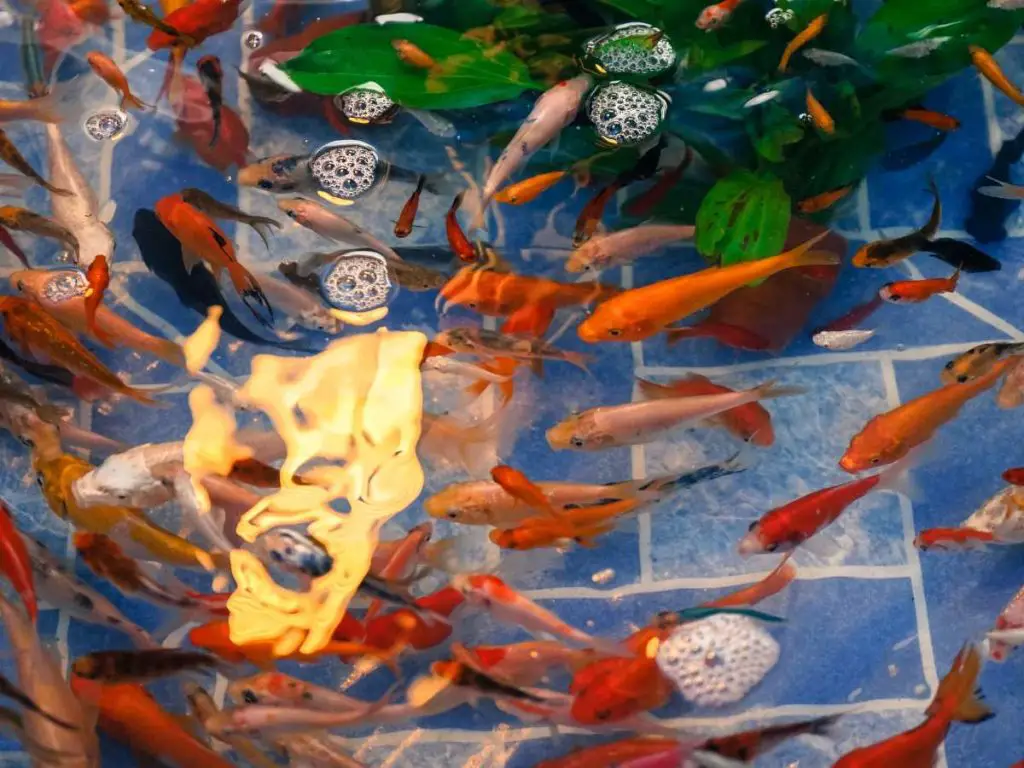
Koi Care and Maintenance Tips
Proper care and maintenance are essential for keeping your koi fish healthy and thriving.
No matter what variety of koi you ultimately choose, here are some important tips to ensure your koi pond remains a flourishing haven for these beautiful creatures.
1. Water quality management
Keeping the water clean and balanced is crucial for the well-being of your koi fish. Regularly test and monitor the water parameters such as pH, ammonia, nitrite, and nitrate levels. Maintain a pH level between 7.0 and 8.0, as this is optimal for koi health. Use a filtration system to remove any harmful substances and keep the water clear.
2. Feeding guidelines
Feeding your koi fish a balanced diet is vital to their overall health and vibrant colors. Choose high-quality koi food that contains essential nutrients and vitamins. Feed them several times a day, but only what they can consume within five minutes. Overfeeding can lead to poor water quality and health issues. Avoid overfeeding your koi fish, as it can lead to obesity and strain on their organs.
3. Regular health checks
Monitor your koi fish regularly for any signs of illness or abnormalities. Look for changes in behavior, appetite, or physical appearance. Inspect their skin for any wounds or growths. If you notice any issues, consult a professional pond specialist or veterinarian who specializes in koi fish. Regular health checks can help detect and treat any problems early, ensuring your koi fish remain healthy and happy.
Reference table: Care requirements for different koi varieties
| Koi Variety | Water Temperature | Feeding Requirements | Special Considerations |
|---|---|---|---|
| Kohaku | 60°F – 75°F | Feed twice daily, small portions | Prone to sunburn, provide shade |
| Taisho Sanke | 50°F – 80°F | Feed once or twice daily, moderate portions | Avoid overcrowding, aggressive behavior |
| Showa Sanshoku | 55°F – 75°F | Feed once or twice daily, small to moderate portions | Monitor skin pigmentation changes |
Remember, every koi variety may have slightly different care requirements based on their specific characteristics. Be sure to research and understand the unique needs of the koi varieties you have in your pond to provide them with the best care possible.
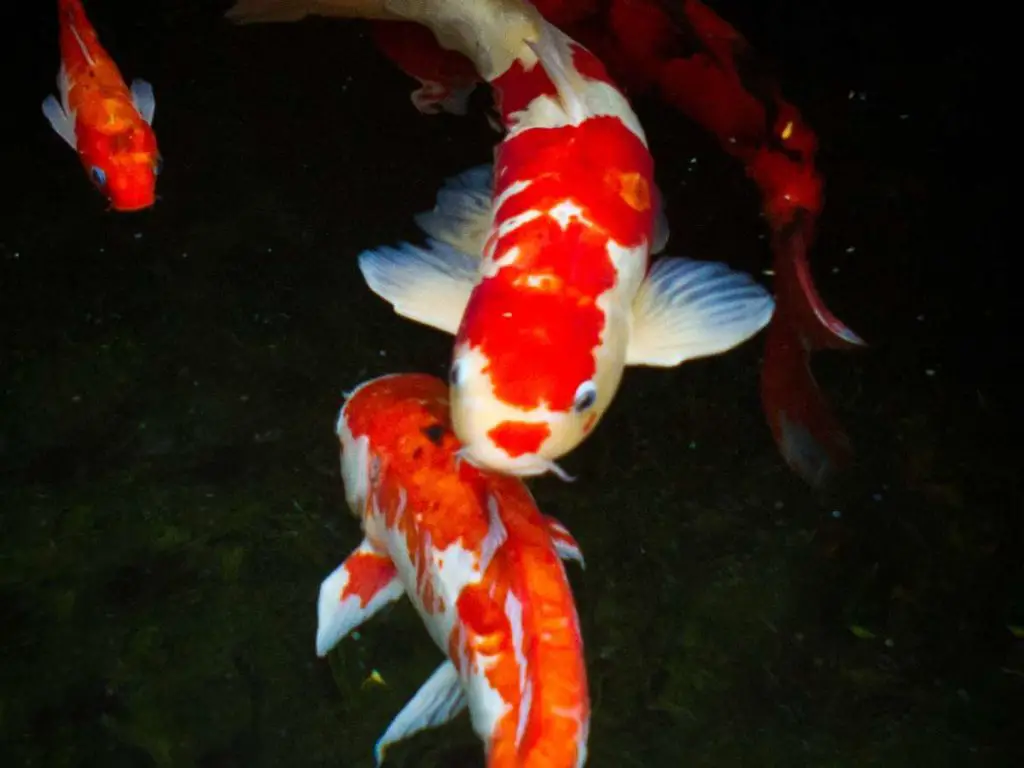
Final Thoughts
Understanding the different varieties of koi fish is crucial if you want to make informed decisions about your pond or garden. Hopefully, this guide has given you a good starting point, but remember to seek further resources and advice from experts in the field. With the right knowledge and care, you can create a vibrant and thriving koi fish habitat that will bring you joy for years to come – with lots and lots of different koi types filling it!
Related Questions
What is the friendliest koi breed?
The Chagoi koi is known for its friendly nature and is often considered the most sociable and docile among koi varieties.
What is the rarest koi fish?
The Ki Utsuri is one of the rarest koi varieties, characterized by its yellow body offset by dramatic black patterns. While the rarity of koi will vary based on regions and availability, the Ki Utsuri is often cited as less common compared to other varieties.
How do I know what kind of koi I have?
To identify the type of koi you have, examine its color patterns, scale distribution, and any unique characteristics. Consulting a koi variety chart or guide can also provide clarity on its specific breed.

